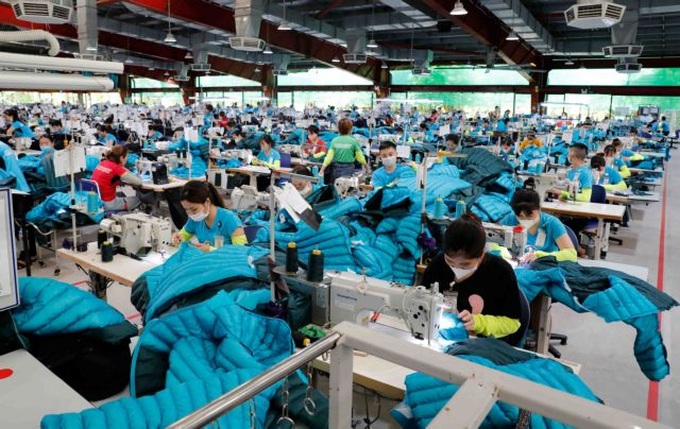
Workers at a Maxport Thai Binh plant producing apparel for export to the US and EU. VNA/VNS Photo
The circular economy, designed to minimise waste and maximise resource efficiency, is becoming central to Vietnam’s industrial restructuring. It is built on three pillars: reducing emissions through optimal use of energy and materials, extending product life via reuse and repair, and recycling waste into new resources.
For the textile and garment sector, one of Vietnam’s top export earners, this shift could be transformational. Between 2025 and 2030, the industry aims to evolve into a high-tech, innovative sector with higher productivity and less reliance on low-skilled labour.
Industry experts say adopting circularity requires eliminating virgin raw materials, reducing microfibre emissions, improving recyclability, and switching to renewable energy. The first step is replacing conventional synthetic inputs with safer, environmentally benign materials to enable closed-loop production.
Nguyen Thi Thanh Phuong, director of the Institute of Environmental Industry, stressed that safe, non-toxic materials are essential. “Materials must be carefully designed to prevent harm throughout their lifecycle, from production to disposal,” she said, noting the need to avoid pollutants such as plastic microfibres, synthetic dyes, and hazardous additives.
Producers are gradually cutting fossil-based polyester use, increasing recycled polyester content, and exploring regenerated cellulose fibres. There is a push for mono-material garments, such as 100 per cent cotton or 100 per cent polyester, which are easier to recycle, as well as biodegradable biopolymers to replace conventional plastics. While virgin polyester may take up to 1,000 years to decompose, certain recycled variants can degrade by 68.8 per cent within 180 days in soil.
Firms are also adopting eco-friendly dyeing technologies, including water-based dyes, supercritical CO2 dyeing, foam dyeing, and plasma treatment, reducing both water and chemical use while maintaining colour quality.
Recycling and closed-loop practices
A major challenge in applying circularity lies in design. Many current production models ignore what happens to garments post-use, creating recycling barriers. Experts call for innovation in materials and improved infrastructure to handle mixed-fibre fabrics and post-consumer waste.
Some Vietnamese companies are leading change. Thanh Cong Textile Garment Investment Trading JSC has developed a closed-loop production system covering yarn manufacturing, weaving, dyeing, and garment assembly. It has increased recycled polyester, viscose, and cotton use, and integrated environmental, social, and governance principles.
Director Phuong said a national innovation programme focused on recycling technology is essential. Better material-sorting systems, she added, would raise recyclate quality and ensure traceable inputs.
Enterprises are investing in emission-reduction and resource-reuse technologies, including digital cutting software, wastewater filtration, heat recovery from dyeing processes, automated fabric waste sorting, and waterless dyeing systems, improving both environmental and economic performance.
At the forefront is Vietnam National Textile and Garment Group (Vinatex), which targets double-digit growth by 2030 through digitalisation, green development, and circular production. Chairman Le Tien Truong said the group’s strategy includes adopting Industry 4.0 technology, restructuring operations, expanding markets, and boosting governance and workforce skills. In 2024, green products made up 25 per cent of Vinatex’s output, including 17,864 tonnes of recycled yarn. The group is shifting from traditional CMT contracts to higher value-added FOB, ODM, and OBM models, and has established a research centre for functional, eco-friendly fabrics.
Another major player, Agtex 28, operates an integrated production line from spinning to garment manufacturing with advanced European and Japanese machinery. It plans to produce three million metres of tie-dyed fabric, 18 million metres of dyed fabric, and 2,500 tonnes of yarn this year.
Vietnam’s textile and garment exports hit USD 44 billion in 2024, making it the world’s second-largest exporter. The industry targets USD 47–48 billion in 2025, with shipments to 132 markets, led by the US, CPTPP members, the EU, South Korea, and China.
By committing to circularity, Vietnam’s textile industry is aligning with global net-zero targets and securing its competitiveness. As international buyers tighten sustainable sourcing rules, compliance is becoming a prerequisite for market access. Vietnamese exporters must meet the EU Waste Framework Directive’s 2025 textile waste collection mandate, the REACH Regulation’s hazardous chemical limits, and the EU Strategy for Sustainable and Circular Textiles, which requires garments to be durable, repairable, recyclable, made mainly from recycled fibres, and free of toxins.
In embracing this shift, Vietnam’s textile and garment sector is not only reducing its environmental footprint but also reinforcing its role in the global supply chain, turning sustainability from a challenge into a long-term competitive advantage.
